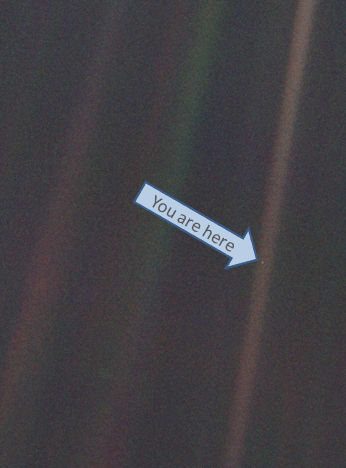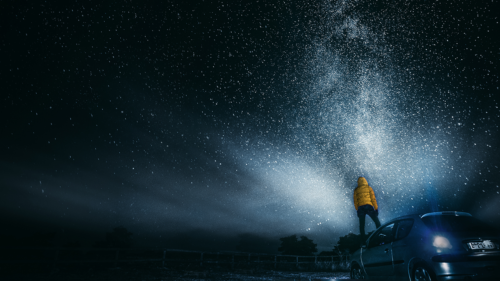Captured by the Voyager 1 space probe from a distance of 3.7 billion miles, this snapshot of the earth as a miniscule pale blue dot suspended in a “ray” of scattered light was made famous by Carl Sagan, whose documentary series Cosmos and books popularized the startling discoveries of modern astronomy. It was used to demonstrate his belief that man’s significance was reduced, minimized, obscured by the vast and impersonal universe:

Our posturings, our imagined self-importance, the delusion that we have some privileged position in the Universe, are challenged by this point of pale light. Our planet is a lonely speck in the great enveloping cosmic dark. In our obscurity, in all this vastness, there is no hint that help will come from elsewhere to save us from ourselves.
-Carl Sagan, Pale Blue Dot
In other musings, Sagan displays a dismissive and cynical attitude toward a religious perspective on the universe:
A universe in which everything is known would be static and dull, as boring as the heaven of some weak-minded theologians.
- Carl Sagan, 'Can We know the Universe?' in M. Gardner (ed.), The Sacred Beetle and Other Great Essays in Science (1985), 109.
And in a truly myopic quote, he opines:
“How is it that hardly any major religion has looked at science and concluded, “This is better than we thought! The Universe is much bigger than our prophets said, grander, more subtle, more elegant?” Instead they say, “No, no, no! My god is a little god, and I want him to stay that way.” A religion, old or new, that stressed the magnificence of the Universe as revealed by modern science might be able to draw forth reserves of reverence and awe hardly tapped by the conventional faiths.”
What is going on here? I mean, how many religious believers aren’t completely gobsmacked by the wonders of creation?

Alternatively, I find myself wholeheartedly agreeing with him when he declares:
At the heart of science is an essential balance between two seemingly contradictory attitudes—an openness to new ideas, no matter how bizarre or counterintuitive they may be, and the most ruthless skeptical scrutiny of all ideas, old and new. This is how deep truths are winnowed from deep nonsense.
-The Demon-Haunted World: Science as a Candle in the Dark (1997), 304.
This “winnowing” is precisely what the next few posts will attempt with results that might have startled Mr. Sagan.
As John Paul II observed:
“Science can purify religion from error and superstition; religion can purify science from idolatry and false absolutes. Each can draw the other into a wider world, a world in which both can flourish.”
-Letter to Rev. George Coyne, S.J., Director of the Vatican Observatory.
To purify and clarify our understanding of religion, Fr. Spitzer’s illuminating examination of the nature of religion will be presented. (As found in Credible Catholic and The Soul’s Upward Yearning.)
Additionally, Fr. Spitzer’s observations about human intelligence provide abundant material for deep reflection and conversation about man’s place in the universe and what it means to be an intelligent observer.
This intelligibility reveals another unique aspect of the living beings inhabiting this “vast” cosmos: intelligent activity permeates every level of living organisms (down to cells). Startlingly, even chemicals display “intelligent” activity. In place of a mechanistic view of the universe (found perhaps unintentionally even in the intelligent design community), we will cast an eye over this dynamic, embedded feature of creation.
But back to the pale blue dot. Sagan’s remark pales in comparison to the words penned 40-50 years before this iconic picture was captured.
The lyric phrasing of Tolkien resonates, indeed reverberates, with awe and wonder in the following description of Ilúvatar’s creation of the fictional world Ea, “the world that is”:
And amid all the splendours of the World, its vast halls and spaces, and its wheeling fires, Ilúvatar chose a place for their habitations in the Deeps of Time and in the midst of the innumerable stars.
-J. R. R. Tolkien, “Ainulindalë”, The Silmarillion)
The religious perspective preserves and enhances the openness to new ideas, to the depths of the mysteries of creation, and finds no shame in praising the Creator of all that is, He who reveals Himself to the hearts of those who seek Him.
For the second article in the Pale Blue Dot series, click here.

